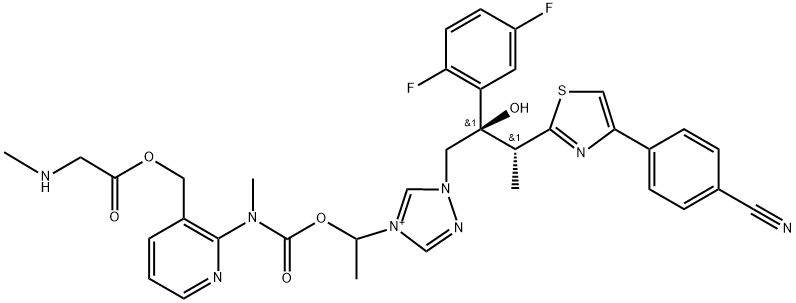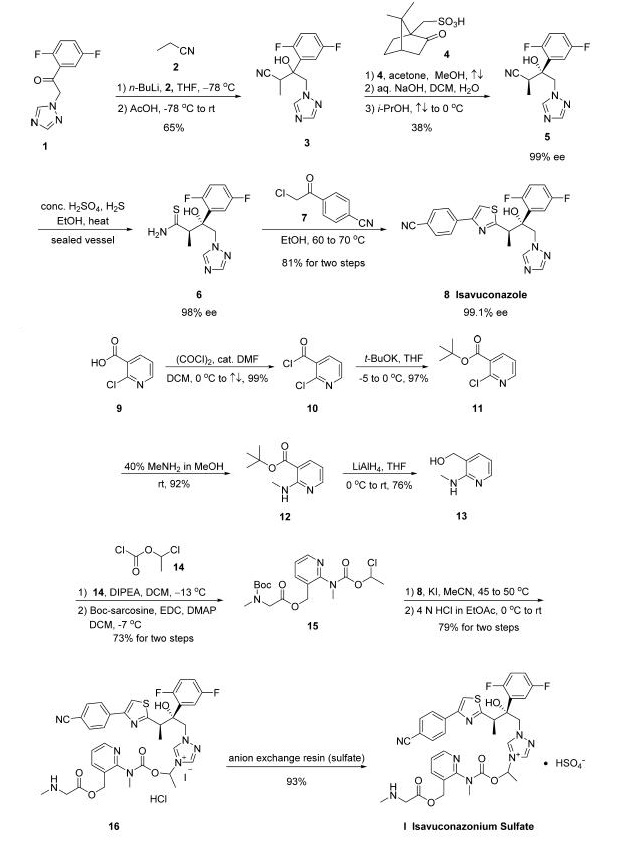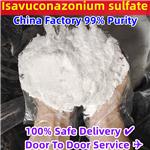
Isavuconazonium sulfate
- Product NameIsavuconazonium sulfate
- CAS742049-41-8
- MFC35H35F2N8O5S+
- MW717.77
- EINECS
- MOL File742049-41-8.mol
Usage And Synthesis
Isavuconazonium
sulfate is a broad spectrum antifungal agent that was
codeveloped by Basilea Pharmaceutica (a subsidiary of
Hoffmann-La Roche acquired in 2000) and Astellas Pharma,
which obtained its first approval by the United States Food and Drug Administration (FDA) for the treatment of invasive
aspergillosis and invasive mucormycosis, available as both oral
and intravenous formulations. Isavuconazonium sulfate is a
water-soluble prodrug, which is rapidly hydrolyzed by esterases
(mainly butylcholinesterase) in plasma into the active moiety
isavuconazole (BAL-4815) and an inactive cleavage product
(BAL-8728). Isavuconazole inhibits cytochrome P450 (CYP)-
dependent enzyme lanosterol 14-ademethylase (CYP51) and
thereby inhibits the synthesis of ergosterol, a key component of
the fungal cell membrane.4 Isavuconazole displayed potent
fungistatic or fungicidal activity in vitro against a broad range of
clinically important yeasts and molds, namely Candida spp.,
Cryptococcus spp., Trichosporon spp., Geotrichum capitatum,
Pichia spp., Rhodotorula spp., Saccharomyces cerevisiae, Aspergillus
spp., and most species known to cause mucormycosis
(Mucorales mucorales). This broad range of antifungal activity renders this drug more clinically appealing compared to other
azoles with narrower indications. Furthermore, isavuconazole
does not require a cyclodextrin vehicle due to its water
solubility, and currently does not require therapeutic drug
monitoring. Moreover, isavuconazole has displayed improved
safety and tolerability compared to voriconazole.
ChEBI: Isavuconazonium is an organic cation that is the cationic portion of isavuconazonium sulfate (a prodrug for isavuconazole, an antifungal agent used for the treatment of invasive aspergillosis and invasive mucormycosis). It has a role as a prodrug, an ergosterol biosynthesis inhibitor, an EC 1.14.13.70 (sterol 14alpha-demethylase) inhibitor and an antifungal agent.
The synthesis of active moiety isavuconazole 8 was started
with commercial 1-(2,5-difluorophenyl)-2-(1H-l,2,4-triazol-lyl)
ethanone (1). Triazole 1 was
treated with n-BuLi followed by exposure to propionitrile (2)
and acidic quench to give racemic alcohol 3 in 65% yield. Next,
resolution of this racemic alcohol was facilitated through the
use of camphor derivative 4 to provide alcohol 5 in 38% yield
and 99% ee. Nitrile 5 was then treated with concentrated
H2SO4 and H2S to furnish thioamide 6, and this was followed
by a cyclization reaction involving 4-(2-chloroacetyl)-
benzonitrile (7) which gave rise to isavuconazole 8 in 81%
yield across the two-step sequence.
The preparation of water-soluble side chain 15 was initiated from commercially available 2-chloronicotinic acid (9), which was converted to the corresponding tert-butyl ester 11 via acid halide 10 in excellent yield for the two-step protocol. Subjection of pyridyl chloride 11 to methanolic methylamine furnished aminopyridine 12 in 92% yield, and this compound was subsequently reduced with lithium aluminum hydride to give aminoalcohol 13 in 76% yield. Next, Nacylation of 13 with 1-chloroethyl chloroformate (14) followed by treatment with N-Boc-sarcosine under esterification conditions delivered chloroethyl ester 15 in 73% yield. The union of the aminopyridyl side chain 15 with thiazoloalcohol 8 was facilitated by reacting the two compounds in the presence of KI in acetonitrile, and this alkylation was followed by removal of the Boc group with hydrochloric acid to give rise to isavuconazonium iodide hydrochloride (16) in 79% yield. Finally, isavuconazonium sulfate (I) was prepared from 16 using an anion exchange resin in 93% yield to finish the construction of the API.
The preparation of water-soluble side chain 15 was initiated from commercially available 2-chloronicotinic acid (9), which was converted to the corresponding tert-butyl ester 11 via acid halide 10 in excellent yield for the two-step protocol. Subjection of pyridyl chloride 11 to methanolic methylamine furnished aminopyridine 12 in 92% yield, and this compound was subsequently reduced with lithium aluminum hydride to give aminoalcohol 13 in 76% yield. Next, Nacylation of 13 with 1-chloroethyl chloroformate (14) followed by treatment with N-Boc-sarcosine under esterification conditions delivered chloroethyl ester 15 in 73% yield. The union of the aminopyridyl side chain 15 with thiazoloalcohol 8 was facilitated by reacting the two compounds in the presence of KI in acetonitrile, and this alkylation was followed by removal of the Boc group with hydrochloric acid to give rise to isavuconazonium iodide hydrochloride (16) in 79% yield. Finally, isavuconazonium sulfate (I) was prepared from 16 using an anion exchange resin in 93% yield to finish the construction of the API.

PROMPT×
PROMPT
The What'sApp is temporarily not supported in mainland China
The What'sApp is temporarily not supported in mainland China
Cancel
Determine
